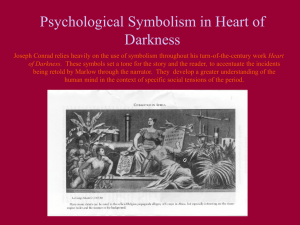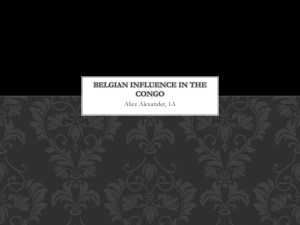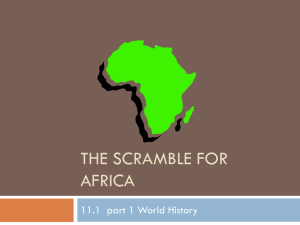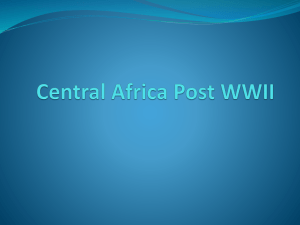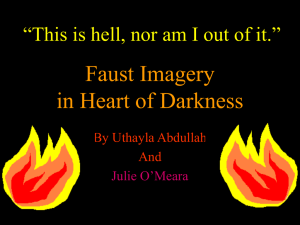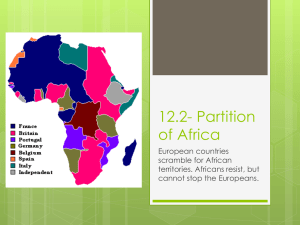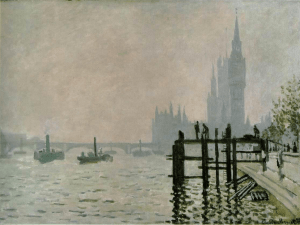Heart of Darkness Lecture HOD is a novel that employs an
advertisement
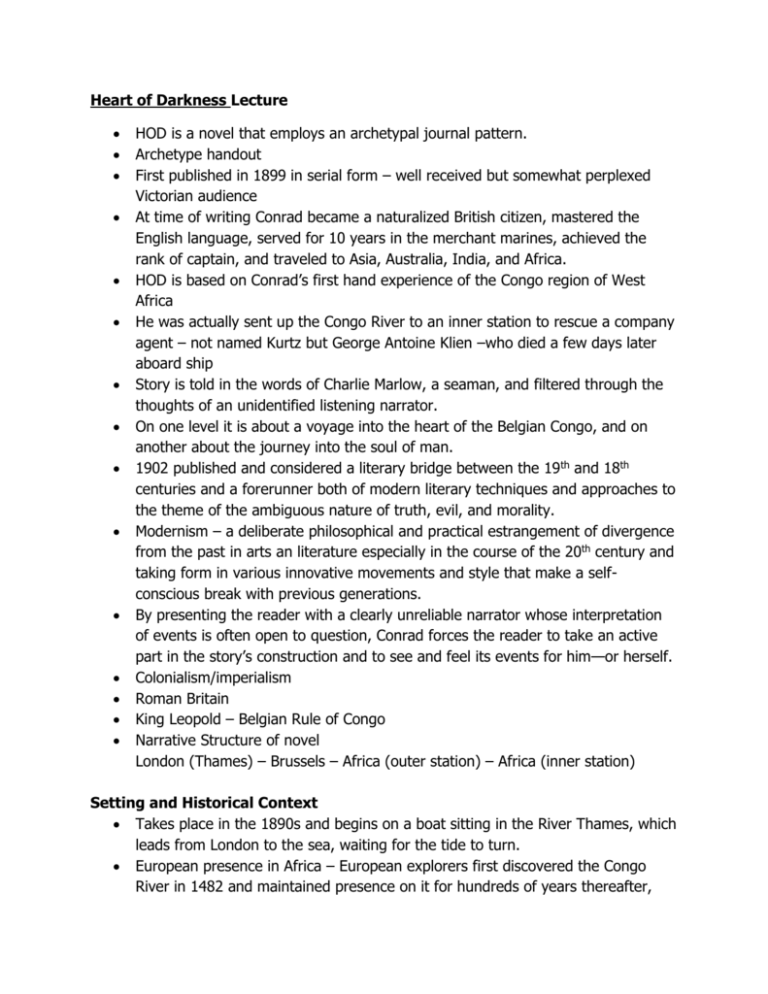
Heart of Darkness Lecture HOD is a novel that employs an archetypal journal pattern. Archetype handout First published in 1899 in serial form – well received but somewhat perplexed Victorian audience At time of writing Conrad became a naturalized British citizen, mastered the English language, served for 10 years in the merchant marines, achieved the rank of captain, and traveled to Asia, Australia, India, and Africa. HOD is based on Conrad’s first hand experience of the Congo region of West Africa He was actually sent up the Congo River to an inner station to rescue a company agent – not named Kurtz but George Antoine Klien –who died a few days later aboard ship Story is told in the words of Charlie Marlow, a seaman, and filtered through the thoughts of an unidentified listening narrator. On one level it is about a voyage into the heart of the Belgian Congo, and on another about the journey into the soul of man. 1902 published and considered a literary bridge between the 19th and 18th centuries and a forerunner both of modern literary techniques and approaches to the theme of the ambiguous nature of truth, evil, and morality. Modernism – a deliberate philosophical and practical estrangement of divergence from the past in arts an literature especially in the course of the 20th century and taking form in various innovative movements and style that make a selfconscious break with previous generations. By presenting the reader with a clearly unreliable narrator whose interpretation of events is often open to question, Conrad forces the reader to take an active part in the story’s construction and to see and feel its events for him—or herself. Colonialism/imperialism Roman Britain King Leopold – Belgian Rule of Congo Narrative Structure of novel London (Thames) – Brussels – Africa (outer station) – Africa (inner station) Setting and Historical Context Takes place in the 1890s and begins on a boat sitting in the River Thames, which leads from London to the sea, waiting for the tide to turn. European presence in Africa – European explorers first discovered the Congo River in 1482 and maintained presence on it for hundreds of years thereafter, never traveling more than 200 miles upstream. Not until 1877 did Henry Morton Stanley journey the course of the Congo and discovered that the Congo extends some 1600 miles into Africa from its eastern coast to its western edge, where the river empties into the Atlantic Ocean and that only one stretch of it is impassable. This section lies between Matadi, 200 miles in from the mouth of the Congo and Kinshasa, yet another 200 miles further inland. In HOD, Conrad called Matadi the Company Station and Kinshasa the Central station. Between those 2 places, one is forced to proceed by land, which is exactly what Marlow does on his “two hundred-mile tramp” between the two Stations described in the book. In 1878, King Leopold II (reigned 1865-1909) of Belgium asked Stanley to found a Belgian colony in the Congo. The King charged Stanley with setting up outposts along the Congo River, particularly at Matadi, Leopold II describe his motives to the rest of Europe as springing from a desire to end slavery in the Congo and civilize the natives. BUT his actual desires were for material gain. In 1885, at the Congress of Berlin, an international committee agreed to the formation of a new country to be known as the Congo Free State. In the novel Conrad refers to the committee as the International Society for the Suppression of Savage Customs. King Leopold II who was the supreme ruler of this land never set foot in the Congo Free State. Instead, he formed a company, called simply the Company that ran the country for him. Leopold claimed all natural resources of the Congo Free State to be his property. This meant that Belgians could stop dealing with African traders and simply take what they wanted themselves. As a consequence, Belgian traders pushed deeper into Africa in search of new sources of ivory, setting up stations all along the Congo River. One of the furthermost stations, located in Stanley Falls, was the likely inspiration for Kurtz’s Inner Station. Belgian atrocities in the Congo – the Belgian traders committed many welldocumented acts of atrocity against the African natives, including the severing of hands and heads. Reports of these atrocities reached the European public, leading to an international movement protesting the Belgian presence in Africa. In 1908, after the Belgian parliament finally sent its own review board into the Congo to investigate, the king was forced to give up his personal stake in the area, and control of the Congo reverted to the Belgian government. The country was granted its independence from Belgium in 1960, and changed its name from the Democratic Republic of Congo to Zaire in 1971. A relatively bloodless revolution in 1997 returned the country’s name to the Democratic Republic of the Congo. Structure of novel Begins in 1890s, goes back several years, and returns to the present. Voyage describes a perfect circle, beginning in Europe, traveling to the African continent, coming out again, and returning almost to the exact spot at which it began. Section I takes the story from the present day life of the unidentified narrator to Marlow’s tale, which began many years before and unfolds over a period of several months. Leads from London in Belgium and from there to the Congo’s Central Station ending with Marlow expressing a limited curiosity about where Kurtz’s supposed moral ideas will lead him. Section II takes the journey through a series of difficulties as it proceeds deeper into the African interior and finally arrives, some two months later, at the Inner Station. It is here that Marlow meets the Russian and is told that Kurtz has “enlarged” his mind. Section III covers the period from Marlow’s eventual meeting with Kurtz to his return to Europe. Symbolism The title of the book itself, Heart of Darkness, alerts the reader to the book’s symbols, or items that suggest deeper interpretations beyond their literal meanings. The “heart of darkness” serves both as an image of the interior of a dark and foreign continent as well as the interior workings of the mind of man, which are dark and foreign to all observers. ***discuss Freudian theories*** Literal journey into the jungle is a metaphor, or symbol, for the journey into the uncharted human soul On another level, the voyage into the wilderness can be read as a voyage back to Eden, or to the very beginning of the world. On another level, the actual trip into and then out of the African continent can be seen as a metaphor for sin and redemption. It parallels the descent into the depths of human degradation and death (in Kurtz’s case; near death in Marlow’s) and the return to the light or life. As the book begins, the Nellie is waiting for the tide to turn. Could be a metaphor for the brewing of a revolution in the Congo at the time, for the tide of history was about to turn. Kurtz can be seen as a symbol for the decaying Western civilization Congo river mirrors the stream of life – sometimes fast, sometimes stagnant. Knitting women waiting outside Marlow’s interview room, who recall the Fates of Greek mythology and thus can be seen as potential judges Cross-legged pose in which Marlow sits during his narration, suggesting the figure of the enlightened Buddha and thus a kind of supreme wisdom. Imperialism British, the policy of uniting the separate parts of an empire with separate governments as to secure for certain purposes a single state. Colonialism The control or governing influence of a nation over a dependent country. Globalization To extend to other or all parts of the globe; make worldwide. During the colonial era, globalization is characterized by the decay of national boundaries and state institutions in favor of transnational economic activity; as well as an explosion in migrations of various peoples in many different directions. Modernism The movement in Roman Catholic thought that sought to interpret the teachings of the Church in the light of philosophic and scientific conceptions prevalent in the late 19th and early 20th century and taking from in any of various innovative movements and styles. Nietzsche -19th century German philosopher used these two ancient gods as metaphors to examine works of literature, especially the genre of tragedy. The Apollonian (The Intended) Apollo was the Greek god of light and is associated with the sun. -god of music, poetry, and prophecy -god of medicine, reason, and self-restraint The Apollonian impulse is for rationality, thought before action, and self-restraint. The Dionysian (Kurtz) Dionysus was a god of wine -born each year and quickly attracted a group of ardent followers who drank wine, danced wildly and went into frenzies while Dionysus played his flute. -at the end of the year, during his final wild celebration, his follower would seize him and rip hip to pieces in an uncontrollable religious passion. -associated with the moon, with loss of control and with the absence of restraint. The Dionysian impulse is toward irrationality, giving in to impulse, and the removal of all boundaries. Marlow functions as a bridge between these two worlds, seeing not only the bright promise of the world suggested by the promise of civilization and progress, but also its fragility as symbolized by the Intended.
